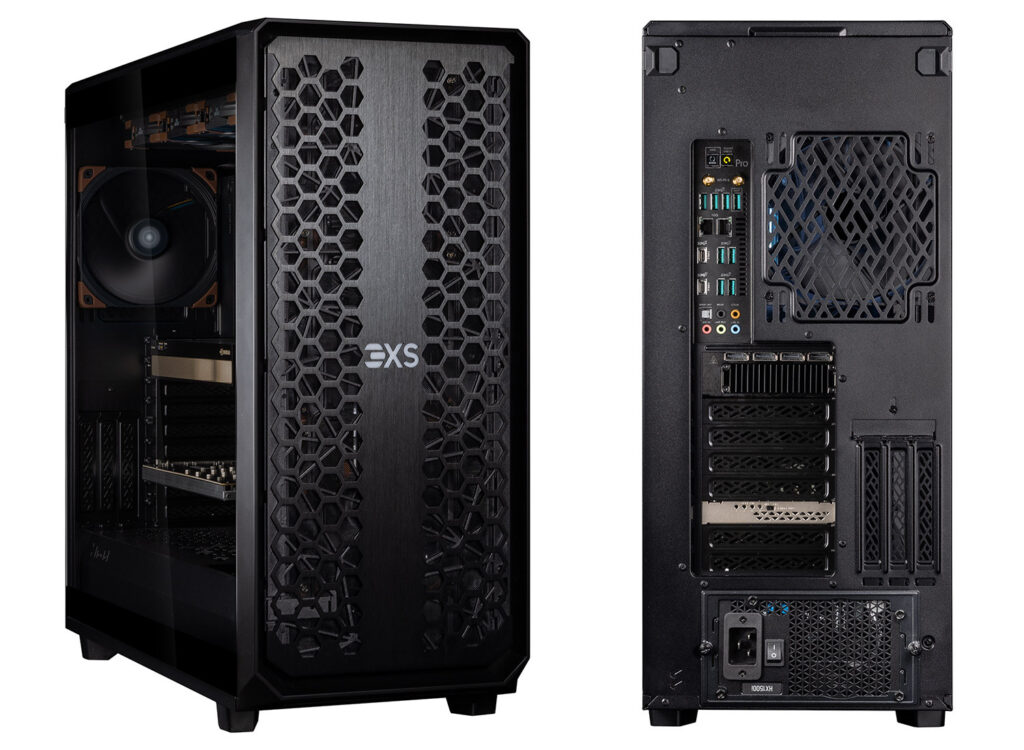Scan 3XS GWP-ME A1128T – With an Nvidia RTX 6000 Ada Generation GPU and 64-core Threadripper Pro CPU, this monster workstation packs a serious punch for the most demanding design viz workflows
For its latest high-performance workstation, Scan has combined two of the most powerful workstation-class processors out there – the 64-core AMD Ryzen Threadripper Pro 5995WX CPU and the Nvidia RTX 6000 Ada Generation GPU.
Coupled with 256 GB of DDR4 memory and an ultra-fast 8TB SSD RAID 0 array, this machine will likely be the envy of most design viz artists.

Given that the Nvidia RTX 6000 Ada Generation is fresh off the production line, it is arguably the silicon star of this workstation. With 48 GB of GDDR6 memory, the ultra-high-end GPU is well equipped to handle the most demanding viz datasets, both in real time 3D and ray tracing / path tracing.
It absolutely obliterated many of the benchmark records set by its predecessor, the Nvidia RTX A6000 (48 GB) (read our review). The biggest gains were seen in GPU ray tracing where the third generation RT cores really come into their own, outperforming the Ampere Generation GPU by a factor of 1.93, 2.05, and 2.19 respectively in the V-Ray, KeyShot, and blender benchmarks. This is a phenomenal generation on generation increase.
It’s no slouch in real time 3D either. In Unreal Engine 4.26 we saw frame rates with our Audi Car Configurator model increase by 1.50 and 1.41 times respectively with ray tracing enabled and disabled. The performance increase rose to 1.63 in arch viz tool Enscape 3.1, and also 1.63 in high-end automotive viz software Autodesk VRED Professional 2023.
To boost performance further, the Scan 3XS GWP-ME A1128T can take a second RTX 6000 Ada Generation GPU, but at £7,149 (Ex VAT) per card, you’ll need seriously deep pockets. This should cut ray trace render times significantly (by up to half), but you won’t get a 96 GB pool of memory to play with like you would with two Nvidia RTX A6000s. Nvidia has dropped support for NVlink. Don’t expect an automatic improvement in 3D frame rates either, as most real time viz tools are not multi-GPU aware.
With so much processing power available through the GPU, it’s easy to forget there’s also a monster Threadripper Pro 5995WX CPU at your disposal. Rendering is an obvious beneficiary of the 64-core CPU but that’s also a job that the RTX 6000 Ada Generation does exceptional well.
Viz users often have well defined rendering pipelines that focus on either CPU or GPU and not necessarily both. That’s not always the case, of course. While V-Ray has entirely different render engines for GPU and CPU and users tend to stick to one, Solidworks Visualize can use both concurrently, and KeyShot allows you to easily swap between GPU and CPU as and when required. This could be to help free up compute resources in order to focus on other workflows, such as real time 3D, video editing or video encoding. Unreal Engine also has different compute-intensive processes that run on CPU and GPU.
CPU rendering also has the benefit of being able to work with incredibly large datasets and with 256 GB of system memory (8 x 32 GB Samsung ECC Registered DDR4 3200MHz) the Scan workstation is certainly well equipped.
With a default TDP of 280W, the Threadripper Pro 5995WX is one of the more challenging CPUs to cool. Scan uses a 360mm Corsair H150i Elite Cappelix RGB hydrocooler mounted in the Fractal Design Meshify 2 case and has replaced the fans with more efficient Noctua models.
This gives enough thermal headroom to increase all core frequencies above the base 2.70 GHz, peaking at 3.05 GHz in both Cinebench and KeyShot 2023.
It’s not the best Threadripper Pro implementation we’ve seen. The Armari Magnetar M64TPRW1300G3 (read our review), with its custom All-in-One (AIO) cooler, manages to hit 3.38 GHz in Cinebench and 3.45 GHz in KeyShot, outperforming the Scan machine by a factor of 1.05 in Cinebench and KeyShot and even more in V-Ray (1.1).
Both processors pump out some serious heat and that’s hardly surprising considering how much power they draw. When rendering in Cinebench (CPU) we recorded 474W at the socket, 550W with V-Ray GPU, and a whopping 740W when using both processors in Solidworks Visualize. The machine was fairly noisy when CPU rendering, less so when GPU rendering.
The chassis is Scan’s trademark Fractal Design Meshify 2 with 3XS custom front panel. It’s a little on the large side (542 x 240 x 474 mm), but is solid and well-built and has a ready supply of ports. Up front and top, there are two USB 3.2 Type A and one USB 3.2 Type C, with plenty more at the rear (eight USB Type-A and two USB 3.2 Type C). For networking there two superfast 10GbE NICs and WiFi 6 built in.
Viz users often have well defined rendering pipelines that focus on either CPU or GPU and not necessarily both. That’s not always the case, of course. While V-Ray has entirely different render engines for GPU and CPU and users tend to stick to one, Solidworks Visualize can use both concurrently, and KeyShot allows you to easily swap between GPU and CPU as and when required. This could be to help free up compute resources in order to focus on other workflows, such as real time 3D, video editing or video encoding. Unreal Engine also has different compute-intensive processes that run on CPU and GPU.
CPU rendering also has the benefit of being able to work with incredibly large datasets and with 256 GB of system memory (8 x 32 GB Samsung ECC Registered DDR4 3200MHz) the Scan workstation is certainly well equipped.
With a default TDP of 280W, the Threadripper Pro 5995WX is one of the more challenging CPUs to cool. Scan uses a 360mm Corsair H150i Elite Cappelix RGB hydrocooler mounted in the Fractal Design Meshify 2 case and has replaced the fans with more efficient Noctua models.
This gives enough thermal headroom to increase all core frequencies above the base 2.70 GHz, peaking at 3.05 GHz in both Cinebench and KeyShot 2023.
It’s not the best Threadripper Pro implementation we’ve seen. The Armari Magnetar M64TPRW1300G3 (read our review), with its custom All-in-One (AIO) cooler, manages to hit 3.38 GHz in Cinebench and 3.45 GHz in KeyShot, outperforming the Scan machine by a factor of 1.05 in Cinebench and KeyShot and even more in V-Ray (1.1).
Both processors pump out some serious heat and that’s hardly surprising considering how much power they draw. When rendering in Cinebench (CPU) we recorded 474W at the socket, 550W with V-Ray GPU, and a whopping 740W when using both processors in Solidworks Visualize. The machine was fairly noisy when CPU rendering, less so when GPU rendering.
The chassis is Scan’s trademark Fractal Design Meshify 2 with 3XS custom front panel. It’s a little on the large side (542 x 240 x 474 mm), but is solid and well-built and has a ready supply of ports. Up front and top, there are two USB 3.2 Type A and one USB 3.2 Type C, with plenty more at the rear (eight USB Type-A and two USB 3.2 Type C). For networking there two superfast 10GbE NICs and WiFi 6 built in.
The Scan 3XS GWP-ME A1128T has some other tricks up its sleeve. While the 2TB Samsung 990 Pro SSD system drive is standard fare for workstations these days, the project drive certainly is not.
The ultra-fast 8TB RAID 0 array is built using four 2TB Samsung 990 Pro NVMe PCIe 4.0 SSDs mounted on an ASUS Hyper M.2 PCIe add-in card, and delivers phenomenal sequential read / write speeds. In CrystalDiskMark we recorded 24.6 GB/s read and 24.8 GB/s write, compared to 7.4 GB/s and 6.8 GB/s on a single 2TB Samsung 990 Pro.
This all sounds great on paper, but the reality is there are only certain workflows that will benefit from such fast storage and only in certain conditions. This includes engineering simulation (with gigantic datasets that don’t fit entirely into system memory), or video editing (with colossal, super high-resolution files). There may be more, and we’d love to hear what they are.
We did see a small benefit over a single SSD when copying files. A zipped file containing 90 GB of point cloud scan data delivered the biggest speed up, with the RAID 0 array finishing 35% faster. The same uncompressed dataset (7,414 scans) was 25% faster, a 3ds max dataset (60 large scene files and 4,400 smaller materials, totalling 4.6 GB) was 24% faster and a Revit dataset (68 files, totalling 4.6 GB) was 11% faster.
Of course, the downside of RAID 0 is it introduces multiple points of failure, so should one drive fail all data is lost. It makes regular backups more important than ever.
The verdict
The Scan 3XS GWP-ME A1128T is a serious workstation for design viz professionals, with buckets of processing power for all different workflows, from real-time to ray trace rendering, video editing and beyond. But it also comes with a serious price tag.
If £16,666 (Ex VAT) seems a lot more than you’re used to paying for a machine of this type, that’s because it probably is. The price of a Threadripper Pro CPU has increased significantly, and the Nvidia RTX 6000 Ada Generation costs considerably more than its predecessor did at launch.
But that’s the current reality of super high-end workstation hardware. Both AMD (CPU) and Nvidia (GPU) have had little in the way of competition in recent times. But with Intel’s long-awaited ‘Sapphire Rapids’ Xeon W-3400 Series CPUs now out and AMD expected to follow the consumer ‘RDNA 3’ Radeon RX 7900 XT with a pro variant, this could change.
Product Specs
Scan 3XS GWP-ME A1128T
■ AMD Ryzen Threadripper Pro 5995WX processor (2.7 GHz, 4.5 GHz boost) (64-cores, 128 threads)
■ Nvidia RTX 6000 Ada Generation GPU (48 GB)
■ 256 GB (8 x 32GB) Samsung ECC Registered DDR4 3200MHz memory
■ 2TB Samsung 990 Pro NVMe PCIe 4.0 SSD
■ 8TB RAID array (4 x 2TB Samsung 990 Pro NVMe PCIe 4.0 SSDs)
■ Asus Pro WS WRX80E Sage SE WiFi motherboard
■ Corsair H150i Elite Cappelix RGB with Noctua fans
■ 1,500W Corsair HXi, 80PLUS Platinum
■ Microsoft Windows 11 Pro
■ 3 Years – 1st Year Onsite, 2nd and 3rd Year RTB (Parts and Labour) warranty
■ £16,666 (Ex VAT)
■ www.scan.co.uk
This article is part of DEVELOP3D’s Workstation Special Report
Scroll down to read and subscribe here
Featuring
- Battle of the desktop workstation CPUs: Intel ‘Sapphire Rapids’ vs AMD Threadripper Pro
- Cloud workstations for CAD, BIM and viz – how the major public cloud providers stack up
- Lenovo ThinkStation P7 / PX desktop workstation reviews
- ‘Sapphire Rapids’ workstation round-up – Dell, HP, BOXX, Scan and Workstation Specialists
- Nvidia RTX 6000 Ada Generation professional GPU review
- AMD Radeon Pro W7800 / W7900 professional GPUs preview
- Reimagining the desktop workstation as a remote resource
- The flexible workstation – supporting the hybrid workforce








